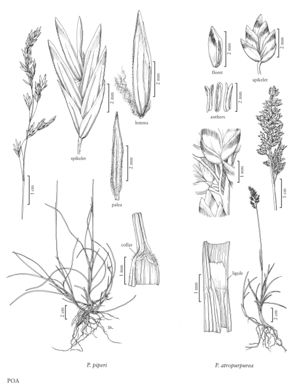Poa piperi
Plants perennial; loosely tufted, rhizomatous. Basal branching extra- and intravaginal. Culms 20-55 cm, erect or the bases decumbent, terete or weakly compressed; nodes terete, 0-1 exserted. Sheaths closed for 1/3-2/3 their length, terete, sparsely to moderately scabrous, glabrous or retrorsely hispidulous, bases of basal sheaths glabrous, distal sheath lengths 2.7-6.5(9.7) times blade lengths; collars of at least some leaves usually sparsely hispidulous; ligules 1-2 mm, scabrous, truncate to obtuse; innovation blades to 40 cm, adaxial surfaces moderately to densely scabrous or hispidulous on and between the veins; cauline blades steeply reduced in length distally, 1-3 mm wide, involute, moderately thick, soft, abaxial surfaces smooth, margins scabrous, apices narrowly prow-shaped, flag leaf blades 1-4.5 cm long. Panicles 4-8 cm, erect to nodding, lanceoloid to ovoid, loosely contracted, sparse, with 18-60 spikelets; nodes with 1-2 branches; branches 3-8 cm, ascending, lax, terete or weakly angled, moderately and sometimes coarsely scabrous, with 3-8 spikelets. Spikelets 6-9(11) mm, lengths to 3 times widths, laterally compressed, not sexually dimorphic; florets 2-5(7); rachilla internodes 1-2 mm, glabrous, scabrous, or sparsely to densely puberulent. Glumes subequal, distinctly keeled; lower glumes 3-veined; calluses diffusely webbed, hairs about 1/2 the lemma length; lemmas 4-6(7) mm, lanceolate, distinctly keeled, glabrous, smooth or sparsely to moderately finely scabrous, keels scabrous, lateral veins moderately prominent, margins glabrous, apices acute; palea keels scabrous, sometimes softly puberulent at midlength; anthers vestigial (0.1-0.2 mm) or 2-3 mm. 2n = 28.
Discussion
Poa piperi grows in forests openings on serpentine rocks in the Coast Ranges of southwestern Oregon and northwestern California. It used to be included in P. rhizomata (p. 546), from which it differs in its involute leaves and glabrous lemmas. It is dioecious.
Selected References
None.
